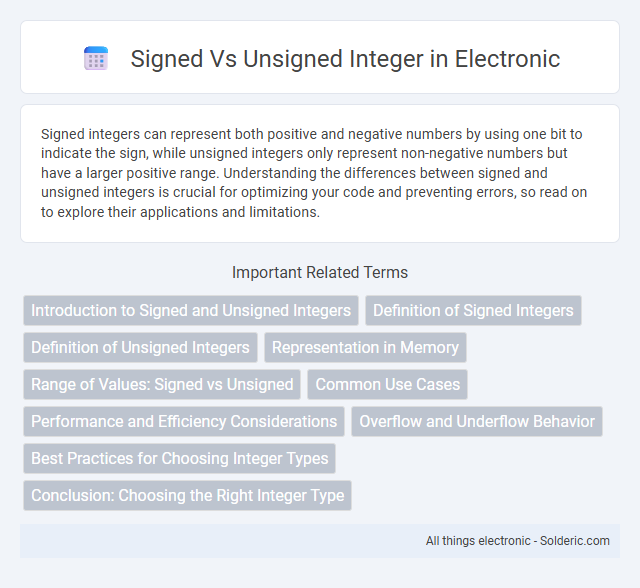Signed integers can represent both positive and negative numbers by using one bit to indicate the sign, while unsigned integers only represent non-negative numbers but have a larger positive range. Understanding the differences between signed and unsigned integers is crucial for optimizing your code and preventing errors, so read on to explore their applications and limitations.
Comparison Table
| Feature | Signed Integer | Unsigned Integer |
|---|---|---|
| Value Range | -2^(n-1) to 2^(n-1)-1 | 0 to 2^n - 1 |
| Bit Usage | 1 bit for sign, remaining for magnitude | All bits for magnitude |
| Example (8-bit) | -128 to 127 | 0 to 255 |
| Use Cases | Handles negative values, arithmetic operations | Only positive values, counting, bitwise operations |
| Overflow Behavior | Wraps around negative and positive limits | Wraps from max to zero |
| Memory Size | Depends on data type (e.g., 8, 16, 32, 64 bits) | Same as signed integer of same bit size |
Introduction to Signed and Unsigned Integers
Signed integers represent both positive and negative whole numbers by allocating a bit for the sign, while unsigned integers contain only non-negative values, maximizing the range of positive numbers. The key difference lies in how the most significant bit (MSB) is interpreted, affecting the minimum and maximum values that can be stored. Understanding this distinction helps you choose the appropriate integer type for memory efficiency and data accuracy in programming.
Definition of Signed Integers
Signed integers are numerical values that can represent both positive and negative numbers by allocating one bit to indicate the sign, typically using two's complement representation. This allows the range of signed integers to extend from approximately -2^(n-1) to 2^(n-1)-1 for an n-bit integer. Understanding signed integers is essential for your programming tasks where negative values must be handled explicitly.
Definition of Unsigned Integers
Unsigned integers represent whole numbers that can only be zero or positive, ranging from 0 to 2^n - 1 for an n-bit system. They do not allocate any bits for sign representation, allowing for a higher maximum value compared to signed integers of the same bit length. Commonly used in programming and digital systems, unsigned integers are ideal for scenarios where only non-negative values are valid, such as memory addresses or binary flags.
Representation in Memory
Signed integers reserve one bit to represent the sign, typically using two's complement notation, which allows them to encode both positive and negative values within a fixed number of bits. Unsigned integers use all available bits solely for magnitude, enabling the representation of larger positive values but no negative numbers. Understanding the memory layout helps you optimize data storage and computational operations based on the range requirements of your application.
Range of Values: Signed vs Unsigned
Signed integers can represent both negative and positive values, typically ranging from -2^(n-1) to 2^(n-1)-1 for an n-bit number. Unsigned integers store only non-negative values, doubling the positive range from 0 to 2^n - 1 compared to their signed counterparts. Understanding the range of values helps you choose the appropriate integer type based on whether negative numbers are required in your application.
Common Use Cases
Signed integers are commonly used in applications requiring the representation of both positive and negative numbers, such as temperature readings, financial calculations, and error codes. Unsigned integers are preferred for scenarios where only non-negative values are needed, including memory addresses, counts, and bitwise operations. Embedded systems and graphics programming often utilize unsigned integers to maximize range and performance.
Performance and Efficiency Considerations
Unsigned integers often provide better performance and efficiency due to simpler arithmetic operations and more predictable overflow behavior, which can optimize low-level computations and memory usage. Signed integers require extra hardware checks for negative values and overflow, potentially increasing processing time and power consumption in critical applications. Choosing the right type aligns with Your system's requirements for speed and resource management, especially in embedded systems and performance-critical code.
Overflow and Underflow Behavior
Signed integers can represent both negative and positive values but overflow occurs when calculations exceed their maximum positive limit, causing the value to wrap around to the minimum negative range. Unsigned integers represent only non-negative values, so overflow results in wrapping back to zero, while underflow causes the value to wrap to the maximum possible number. Understanding this behavior is crucial for your programs to prevent unexpected results and ensure accurate arithmetic operations in digital systems.
Best Practices for Choosing Integer Types
Choosing between signed and unsigned integers depends on the range of values your application requires; use unsigned integers when you need to represent only non-negative values, maximizing the positive range. Signed integers are preferable if your data includes negative numbers or arithmetic operations that can generate negative results. Your code's readability and error prevention improve by selecting types that align with the value domain and overflow behavior expected in your use case.
Conclusion: Choosing the Right Integer Type
Selecting between signed and unsigned integers depends on the range of values required and the specific application needs. Signed integers accommodate both positive and negative numbers, ideal for calculations involving negative values, while unsigned integers allow only non-negative values but offer a larger positive range within the same bit-width. Optimizing for memory efficiency and preventing overflow errors requires careful analysis of the data domain and the expected numerical boundaries in your program.
Signed vs Unsigned integer Infographic

 solderic.com
solderic.com